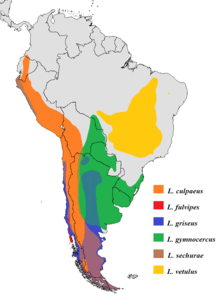| Lycalopex | |
|---|---|

| |
| Scientific classification | |
| Domain: | Eukaryota |
| Kingdom: | Animalia |
| Phylum: | Chordata |
| Class: | Mammalia |
| Order: | Carnivora |
| Family: | Canidae |
| Tribe: | Canini |
| Subtribe: | Cerdocyonina |
| Genus: | Lycalopex Burmeister 1854 |
| Type species | |
| Canis magellanicus | |
| Species | |

| |
| Range of the six living zorro species | |
| Synonyms | |
| |
The South American foxes (Lycalopex), commonly called raposa in Portuguese, or zorro in Spanish, are a genus from South America of the subfamily Caninae. Despite their name, they are not true foxes, but are a unique canid genus more closely related to wolves and jackals than to true foxes; some of them resemble foxes due to convergent evolution. The South American gray fox, Lycalopex griseus, is the most common species, and is known for its large ears and a highly marketable, russet-fringed pelt.
The second-oldest known fossils belonging to the genus were discovered in Chile, and date from 2.0 to 2.5 million years ago, in the mid- to late Pliocene. The Vorohué Formation of Argentina has provided older fossils, dating to the Uquian to Ensenadan (Late Pliocene).
Names
The common English word "zorro" is a loan word from Spanish, with the word originally meaning "fox". Current usage lists Pseudalopex (literally: "false fox") as synonymous with Lycalopex ("wolf fox"), with the latter taking precedence. In 1895, Allen classified Pseudalopex as a subgenus of Canis, establishing the combination Canis (Pseudalopex), a name still used in the fossil record.
Species
Species currently included in this genus include:
| Image | Name | Common name | Distribution |
|---|---|---|---|
 |
Lycalopex culpaeus | Culpeo or Andean fox | Ecuador and Peru to the southern regions of Patagonia and Tierra del Fuego |
 |
Lycalopex fulvipes | Darwin's fox | Nahuelbuta National Park (Araucanía Region), the Valdivian Coastal Range (Los Ríos Region) in mainland Chile and Chiloé Island |
 |
Lycalopex griseus | South American gray fox or chilla | Argentina and Chile |
 |
Lycalopex gymnocercus | Pampas fox | northern and central Argentina, Uruguay, eastern Bolivia, Paraguay, and southern Brazil |
 |
Lycalopex sechurae | Sechuran fox | west-central, northwestern Peru, including the Sechura Desert, and southwestern Ecuador |
 |
Lycalopex vetulus | Hoary fox | south-central Brazil |
| †Canis (Pseudalopex) australis | Vorohué Formation, Uquian-Ensenadan Argentina |
In 1914, Oldfield Thomas established the genus Dusicyon, in which he included these zorros. They were later reclassified to Lycalopex (via Pseudalopex) by Langguth in 1975.
Phylogeny
The following phylogenetic tree shows the evolutionary relationships between the Lycalopex species, based on molecular analysis of mitochondrial DNA control region sequences.
| Lycalopex |
| ||||||||||||||||||||||||||||||
Relationship with humans
The zorros are hunted in Argentina for their durable, soft pelts. They are also often labelled 'lamb-killers'.
In his diary of his well-known 1952 traveling with the young Che Guevara, Alberto Granado mentions talking with seasonal workers employed on vast sheep farms, who told him of a successful campaign by the ranch owners to exterminate the foxes who were preying on lambs. The ranchers offered a reward of one Argentinian peso for the body of a dead male fox and as much as five pesos for a female fox; to impoverished workers in the early 1950s, five pesos were a significant sum. Within a few years, foxes became virtually extinct in a large part of Argentina.
The Fuegian dog (Spanish: perro yagán, perro fueguino), also known as the Yaghan dog, was a domesticated form of the culpeo (Lycalopex culpaeus), unlike other domesticated canids which were dogs and silver foxes. This means different canid species have been domesticated multiple times by humans independently.
References
- ^ Wozencraft, W. C. (2005). "Order Carnivora". In Wilson, D. E.; Reeder, D. M. (eds.). Mammal Species of the World: A Taxonomic and Geographic Reference (3rd ed.). Johns Hopkins University Press. ISBN 978-0-8018-8221-0. OCLC 62265494.
- ^ "Canis (Pseudalopex) australis Kerr 1792". Fossilworks. Gateway to the Paleobiology Database. Retrieved 15 December 2021.
- Wilson, D. E.; Reeder, D. M., eds. (2005). Mammal Species of the World: A Taxonomic and Geographic Reference (3rd ed.). Johns Hopkins University Press. ISBN 978-0-8018-8221-0. OCLC 62265494.
- Lucherini, M. & Luengos Vidal, E. M. (2008). "Lycalopex gymnocercus (Carnivora: Canidae)". Mammalian Species. 820: Number 820, pp. 1–9. doi:10.1644/820.1. hdl:11336/115900.
- ^ Vorohuen (sic; Vorohué) Formation at Fossilworks.org
- Lucherini, M. (2016). "Lycalopex culpaeus". IUCN Red List of Threatened Species. 2016: e.T6929A85324366. doi:10.2305/IUCN.UK.2016-1.RLTS.T6929A85324366.en. Retrieved 11 November 2021.
- Tchaicka, Ligia; Freitas, Thales Renato Ochotorena de; Bager, Alex; Vidal, Stela Luengos; Lucherini, Mauro; Iriarte, Agustín; Novaro, Andres; Geffen, Eli; Garcez, Fabricio Silva; Johnson, Warren E.; Wayne, Robert K.; Eizirik, Eduardo (2016). "Molecular assessment of the phylogeny and biogeography of a recently diversified endemic group of South American canids (Mammalia: Carnivora: Canidae)" (PDF). Genetics and Molecular Biology. 39 (3): 442–451. doi:10.1590/1678-4685-GMB-2015-0189. PMC 5004827. PMID 27560989.
- TRAVELLING WITH CHE GUEVARA by Alberto Granado
- Petrigh, Romina S.; Fugassa, Martin H. (December 13, 2013). "Molecular identification of a Fuegian dog belonging to the Fagnano Regional Museum ethnographic collection, Tierra del Fuego" (PDF). Quaternary International. 317: 14–18. Bibcode:2013QuInt.317...14P. doi:10.1016/j.quaint.2013.07.030. Archived from the original (PDF) on December 20, 2016. Retrieved September 2, 2020.
Further reading
- Nowak, Ronald M. (2005). Walker's Carnivores of the World. Baltimore: Johns Hopkins Press. ISBN 0-8018-8032-7
| Extinct Canidae | |||||||||||||||||||||||||||||||||||||||||||||||||
|---|---|---|---|---|---|---|---|---|---|---|---|---|---|---|---|---|---|---|---|---|---|---|---|---|---|---|---|---|---|---|---|---|---|---|---|---|---|---|---|---|---|---|---|---|---|---|---|---|---|
| |||||||||||||||||||||||||||||||||||||||||||||||||
| |||||||||||||||||||||||||||||||||||||||||||||||||
| |||||||||||||||||||||||||||||||||||||||||||||||||
| |||||||||||||||||||||||||||||||||||||||||||||||||
| |||||||||||||||||||||||||||||||||||||||||||||||||
| Taxon identifiers | |
|---|---|
| Lycalopex | |
| Pseudalopex | |









